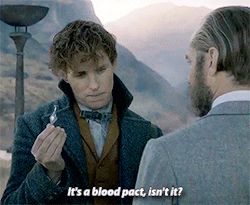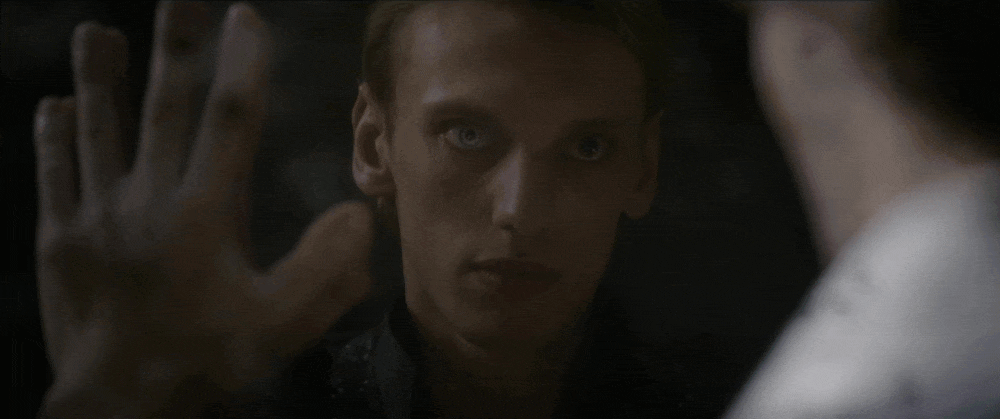The Blood Pact: Symbolism, Subtext, and Queerbaiting
For the record, I thoroughly enjoyed Fantastic Beasts: The Crimes of Grindelwald. That doesn’t mean I have nothing critical to say about it. I think there’s tremendous value in being critical of something I love. With that in mind, let’s talk about the blood pact.
When Dumbledore said, “I can’t move against Grindelwald,“ my interpretation was that he feared the emotional pain of doing so would be too much for him to bear. Dumbledore’s Mirror of Erised vision seemed to confirm my suspicions. Dumbledore could have fought Grindelwald, but he was afraid that Grindelwald would prove too strong a temptation for the part of his heart that still deeply, desperately desired him.
Then, we learned that Dumbledore’s hands weren’t metaphorically tied, but literally tied; he can’t move against Grindelwald because of the blood pact. Dumbledore is now primarily held back not by his complicated feelings for Grindelwald, but by a physical manifestation of them. That was a striking shift in tone.
The blood pact doesn’t erase the growth Dumbledore will have to go through, the hard truths about himself he must confront before he faces Grindelwald. I wouldn’t be surprised if breaking the blood pact requires some complex, powerful magic that Dumbledore won’t be able to perform until he breaks the deep emotional connection he has to Grindelwald. But the blood pact does lower the emotional stakes by shifting our focus away from Dumbledore’s inner turmoil and onto a physical object. We no longer have to watch Dumbledore do the tremendous emotional labor of owning up to his mistakes and letting go of his past. The work he does to break the blood pact symbolizes, and thus replaces, that emotional labor. It is this use of symbolism that makes me so uneasy.
The exact nature of the strong connection symbolized by the blood pact is left ambiguous. Whether the pact was made out of love, out of friendship, or as a simple insurance policy is left up to the audience. There are hints of deep love and lingering attachment hiding in the subtext – in the melancholy music, the intimate hand-touching, and Dumbledore’s pained expression – and some may call those hints too obvious to ignore, but there will always be those who simply refuse to see them. Viewers, including those who obstinately maintain that Dumbledore is not gay, thank you very much, can interpret that symbolism and subtext however they want.
J.K. Rowling said over a decade ago that Dumbledore was gay. The creators of Fantastic Beasts told us that Dumbledore’s love for Grindelwald would be decipherable, if not explicit, in Crimes of Grindelwald. There are three movies left in which they can explicitly address Dumbledore’s sexuality, and I’m still hopeful they will. But they could also in those three movies use the blood pact to appease fans who interpret it as a symbol of romance without ever having to define Dumbledore as gay. That, my friends, is called queerbaiting, and I’ve had enough of it.
Okay, it is too early for me to outright condemn the blood pact as queerbaiting, but the warning signs are definitely there. The very existence of the blood pact says everything while saying nothing at the same time. The blood pact was created in a moment that can be read as intimate, or not. “Oh, we were closer than brothers” could mean they were in love, or not. Symbols exist so that creators don’t have to do the work of telling their audiences exactly what they mean. And the maddening reality is that stories about people like Dumbledore are often told through symbolism and subtext for precisely that reason, so creators can avoid the consequences of making their characters explicitly queer.
That the Potter franchise is not nearly as progressive or inclusive as it claims to be is old news to anyone who ships Albus Potter and Scorpius Malfoy. The blood pact is an opportunity for Fantastic Beasts to continue that trend, to make Dumbledore’s queerness obvious, but only in the subtext, and to do everything except outright confirm that Dumbledore and Grindelwald were romantically connected. But it is also an opportunity to clarify rather than obscure Dumbledore’s feelings for Grindelwald, and I still have hope that this story is heading down the latter path.
One of the most powerful and well-respected leaders of the wizarding world is also a gay man. That kind of visible representation does not exist anywhere else in the Potter universe and rarely exists outside of it. Far too many movies, shows, and books make queer people and queerness itself into something invisible and imaginary, something that should be hidden and can be ignored, something you can wish for all you want but will never be real. Couching a character’s queerness in subtext means leaving queer fans in the subtext too. But queer Potter fans are very real and deserve a Dumbledore whose sexuality is real, not hidden in a blood pact. Let’s hope Fantastic Beasts isn’t yet another story that is ashamed or afraid to make its queer characters visible and real.







